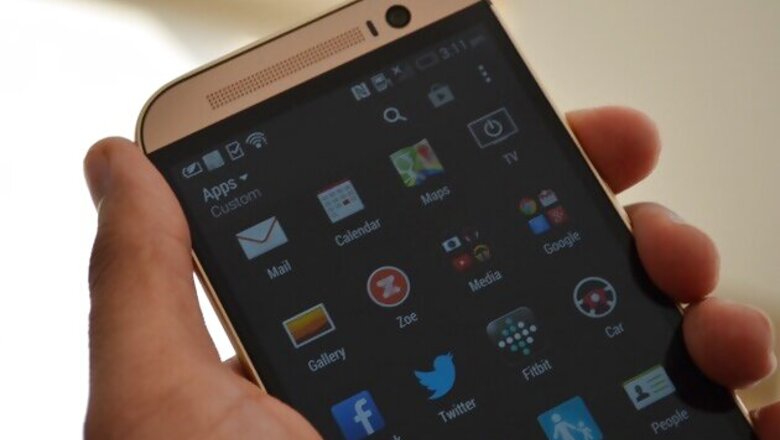
views
New Delhi: HTC, which had reinvented itself with the One Brand last year, uncovered its next-gen One smartphone - named HTC One (M8) - on Tuesday. While the company took the wraps off the device at its events in New York and London, it had organised an extensive demo session for media in New Delhi a couple of hours ahead of the official launch. Based on our pre-launch experience with the phone, here are the first impressions that the device left on us.
The HTC One (M8) has a full metal body with a 5-inch display. Quite like its predecessor, the new HTC One has a unibody design with a non-removable back, but the new flagship phone has a metallic back with a fine hairline brush finish which gives it a premium look and feel. Its thin edges and gentle curves make it comfortable to hold.
The phone's 5-inch full HD display is of excellent quality, in terms of colour accuracy, touch responsiveness and viewing angles. The HTC One (M8) runs Android with its new Sense 6 layer atop, which the company says is completely redesigned with cleaner and vibrant colours. Like the last year's HTC One, the new flagship smartphone also includes Blinkfeed - a feature that brings your content to the homescreen and lets you customise the content you want to highlight on the homescreen.
The phone will come in 16GB and 32GB versions; the company says the 16GB variant will be initially launched in India, while the 32GB version may come come later. Unlike the previous-generation HTC One that did not allow users to expand memory, the HTC One (M8) supports a microSD card of up to 128GB for additional storage.
Though the HTC One (M8) has the same 4.1 megapixel Ultrapixel camera as the HTC One, but the new phone comes with a dual camera setup at the back. (If you have forgotten or are unaware of what HTC's Ultrapixel technology is, here I restate. The company describes the UltraPixel sensor to have larger pixels, and each pixel is claimed to capture 300 per cent more light than the most leading smartphone cameras. This is because the larger each pixel on the image sensor is, the more light it receives, and therefore the image data becomes better.)
The advantage of having this dual camera technology on the new HTC One (M8) phone is that you can refocus any part of the image after it has been clicked. In an oversimplified way, the camera at the bottom works as your primary rear camera, while the one at the top of the back panel understands the depth in your image and thus lets you refocus different parts of the image. This is something I liked in the phone - at least in the initial usage. Its camera also includes other new features like it lets you give your image a new season in an instant, apply different effects to elements in background without changing the foreground, which appear a little gimmicky.
It comes with a dual-colour LED flash, which HTC says is first of its kind on an Android phone. The purpose here is to help people take more natural photos. For selfie lovers, HTC has put up a 5 megapixel BSI, wide-angle lens on the front. Both rear and front cameras captured to-notch pictures in soft light. We will test its camera under different lighting conditions before we give any judgement on its camera.
HTC's new phone includes some gestures such as double tap on the screen to wake it up or double tap again to put it to sleep. This is something we have already seen on the LG G2. Other gestures on the HTC One (M8) include swipe up from the screen to go to the last up, swipe down to go to voice command, hold landscape and press the volume button to launch the camera app, and swipe right to go directly to Blinkfeed.
Like the HTC One, it also has dual frontal BoomSound speakers which the company claims are 25 per cent louder sound than the HTC One. During the presentation early on Tuesday, the company official played a song from the movie 'Frozen' on the HTC One (M8), and its speakers produced richer and punchier sounds across all spectrums. The phone undoubtedly has great speakers.
Its other specs include Qualcomm snapdragon 801 processor, which powers the Galaxy S5 and Sony Xperia Z2, 2GB of RAM and 2600mAh battery. The HTC One (M8)'s battery is touted to offer 40 per cent longer battery life than the last-gen model. The phone takes one hour to charge 80 per cent of its battery, claims the company.
HTC already has a power saving mode in its phones, but with the HTC One (M8), it has gone a step ahead and has come up with a new feature - Extra Power Saving Mode - which if enabled, can keep your phone on standby for up to 2 weeks, with access to essentials including calling, messaging, calculator, mails and calendar. These are HTC's claims, which we are yet to test.
The HTC One (M8) phone will come in three colours - Gunmetal Grey, Glacial Silver and Amber Gold. In India, it will initially come in the first two colours, while the gold-coloured variant will be launched later.
The company says that the phone will be available in India starting from the third week of April, while it will go on sale in some countries on April 1. The company has no plans to bring the dual SIM version of the phone to India.
####





















Comments
0 comment